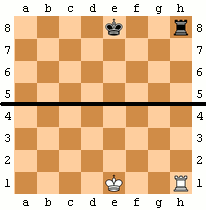Rook (chess)
A rook (from Persian رخ rokh) is a piece in the board game of chess. It gets its name from its name in the old Indo-Persian game (see History of chess). Each player starts the game with two rooks. When recording games, it is shortened to R, and when printed a figurine is used.
| Chess pieces | ||
|---|---|---|
| King | ||
| Queen | ||
| Rook | ||
| Bishop | ||
| Knight | ||
| Pawn | ||
Starting place and moving
| [[Image:chess __
d44.png|22px|alt=h8 __|link=]] |
|||||||||
| [[Image:chess oo
l44.png|22px|alt=h7 white circle]] | |||||||||
| [[Image:chess __
d44.png|22px|alt=h6 __|link=]] | |||||||||
| 22px | [[Image:chess xx
l44.png|22px|alt=h5 cross]] | ||||||||
| [[Image:chess __
d44.png|22px|alt=h4 __|link=]] | |||||||||
| [[Image:chess __
l44.png|22px|alt=h3 __|link=]] | |||||||||
| [[Image:chess __
d44.png|22px|alt=h2 __|link=]] | |||||||||
| [[Image:chess __
l44.png|22px|alt=h1 __|link=]] | |||||||||
In chess notation, the white rooks start on the a1 and h1 squares, and the black rooks start on the a8 and h8 squares.
The rook moves forward or back on the files through any number of squares without other pieces on them, and sideways on the ranks. This is shown in the diagram below. Like other pieces, it captures by going into the square on which an enemy piece stands.
The rook and king also take part in a special move called castling.
Rook (chess) Media
19th-century illustration of a siege tower, which the rook may be intended to represent
The berserker used as a rook in the Lewis chessmen
Arms of the English family of Rookwood, featuring chess rooks as a cant on the name






